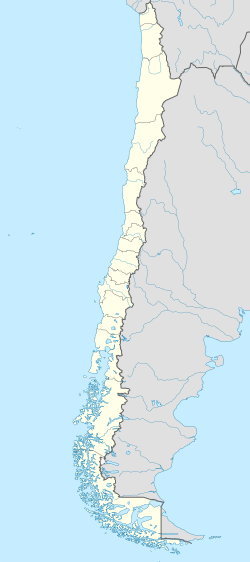
Since at least 2010 Chile's has each year produced 0.6% to 0.7% of all iron mined in the world.[1] Production has risen from 6.8 million metric tonnes in 2010 to more than 10 million metric tonnes each year beginning 2021.[1] As of 2023 about 15% of the value of Chilean iron exports comes from iron ore pellets and the remaining from bulk ore.[2] The northern regions of Atacama and Coquimbo hosts all iron mining in Chile.[2] Until 2014 Antofagasta Region was also active in iron mining.[2] In the 2014–2023 period iron ore has stood each year from 0.9 to 2.6% of the total value of Chilean exports.[2] Most iron ore mined in Chile is exported to China and far behind South Korea and Bahrain are important markets.[2]
Mining of iron ore deposits along the Chilean Iron Belt have been facilitated by their proximity to the ports of export at the coast, and this had in particular had an impact for the economic viability of small iron ore deposits.[3] Compañía Minera del Pacífico (CMP) is largest iron mining company in Chile.[4] Is through its parent company Compañía de Acero del Pacífico (CAP) a member of Consejo Minero, a guild of large mining companies in the country.[5] Compañia Minera del Pacífico has three main mines each with its own port for export.[6] Near Copiapó the company owns Cerro Negro Norte mine which uses the port of Punta Totoralillo, further south the company is in ownership of Los Colorados mine which uses the port of Guacolda II, and near the city of La Serena El Romeral mine is operated using the port of Guayacán in Coquimbo.[6]
In medium-scale iron mining in Chile the mines and deposits of El Carmen, Huantemé, Cerro Imán and El Dorado are important.[7]
The Dominga project led by Andes Iron seeks to establish a new iron and copper mine near the coast of northern Coquimbo Region.[8] This project has proved controversial for political and environmental reasons.[8]
Iron mining in Chile is thought to have the potential to produce cobalt as by-product.[9]
Civil engineer Carlos Vattier and geologist Juan Brüggen were among the first to assess the ores of the Chilean Iron Belt in the late 19th century and early 20th century.[10][11][7][12] Iron mining industry in the Chilean Iron Belt have had a significant presence of Chilean Hungarians entrepeneurs since the 1950s.[13][14][15]
- ^ a b Cifras actualizadas de la minería (Report) (in Spanish). Consejo Minero. 2025-03-01. p. 4.
{{cite report}}: CS1 maint: date and year (link) - ^ a b c d e Anuario de estadisticas del cobre y otros minerales [Yearbook: Copper and Other Mineral Statistics: 2004 2023] (Report). Comisión Chilena del Cobre. 2024.
- ^ Millán 1999, p. 92.
- ^ "CMP". Consejo Minero (in Spanish). Retrieved 2025-05-10.
- ^ "Grupo minero CAP se incorpora al Consejo Minero y se conveirte en la primera productora de hierro en sumarse a la entidad gremial". Portal Minero (in Spanish). 2017-07-03. Retrieved 2025-04-30.
- ^ a b "Iron Market". CMP. Retrieved 2025-05-14.
- ^ a b Millán 1999, p. 192.
- ^ a b Laborde, Antonia (2024-12-10). "El millonario proyecto minero Dominga vuelve a las manos del Gobierno de Boric". El País (in Spanish). Retrieved 2025-05-15.
- ^ Townley, Brian; Díaz, Alejandro; Luca, Rodrigo (2017). Exploration and mining potential for cobalt mineral resources in Chile (Report).
- ^ Millán 1999, p. 21.
- ^ Millán 1999, p. 23.
- ^ Millán 1999, p. 193.
- ^ Millán 1999, p. 95.
- ^ Millán 1999, p. 110.
- ^ Millán 1999, p. 113.
© MMXXIII Rich X Search. We shall prevail. All rights reserved. Rich X Search

